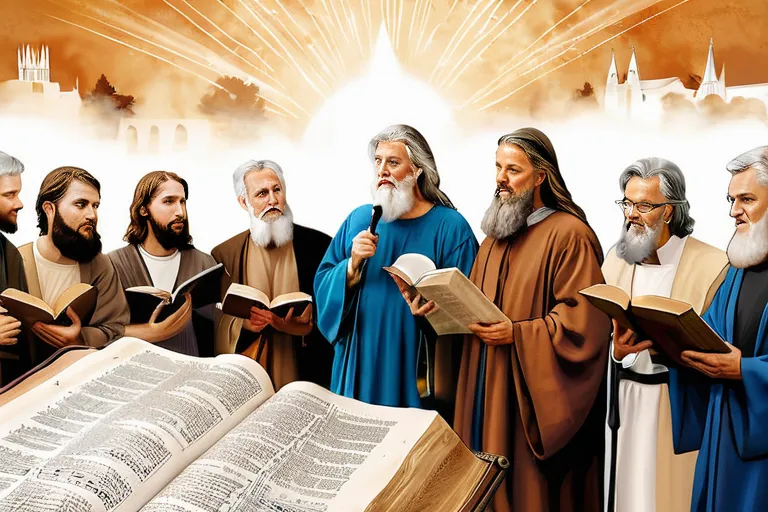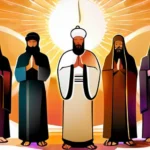Exploring the Significance and Impact of Old Testament Prophets on Christian Beliefs
Delve into the profound role that Old Testament prophets played in shaping the foundations of Christianity. From their prophetic messages to their influence on Jesus Christ, we will explore how these ancient figures continue to resonate within modern Christian faith.
The Prophetic Tradition
Imagine the Old Testament as a vast, ancient library filled with scrolls that whisper tales of divine revelations. Among these tales are the stories of the prophets, who served as the messengers of God. How did prophecy arise within this sacred text? It began in the early days when people sought to understand their place in a world often shrouded in mystery and chaos.
The concept of prophecy was more than just foretelling future events; it was a profound means of divine communication. These prophets were like beacons, guiding their people through times of darkness with words of wisdom and warnings. But who exactly are these prophets? What made them so significant in the eyes of both Judaism and Christianity?
Consider Moses, often referred to as the first prophet. His story is one of leadership and divine appointment. Through his prophetic voice, he led a nation out of slavery and onto the path of freedom and covenant with God. How can we fully grasp the impact of Moses’ words without understanding the magnitude of his role in shaping religious beliefs?
Then there’s Isaiah, whose visions painted vivid pictures of a future where justice prevails and the people are saved from their sins. His prophetic messages were not just about the hereafter but also called for ethical living and societal reform in the present. How do these messages resonate with Christian teachings on repentance and redemption? Can we see Isaiah’s influence in the New Testament?
Jeremiah, on the other hand, brought a message of judgment against those who were turning away from God. His cries for repentance echoed through the centuries, challenging not just the people but also Christians to hold onto their faith during times of adversity. How did Jeremiah’s warnings shape Christian understanding of the consequences of disobedience? What lessons can we learn from his enduring legacy?
The role of these prophets was multifaceted—guiding, warning, and inspiring. They were like lighthouses in a tumultuous sea, offering hope and direction to those who sought it. In exploring the significance and impact of Old Testament prophets on Christian beliefs, we uncover a rich tapestry of spiritual guidance that continues to influence religious thought and practice today.
Key Figures in the Old Testament
Imagine a world where voices, often whispering from distant corners, guide and warn the people through the fog of uncertainty. These are the prophets of the Old Testament, whose words have echoed through time and continue to resonate in Christian beliefs today. How did these individuals become so pivotal? Could it be that their role was not just about speaking, but about being a beacon of hope in troubled times?
Moses, often called the first prophet, serves as an iconic figure, leading his people out of slavery with his staff and the commandments given at Mount Sinai. Can you imagine the profound impact these 10 words had on shaping not just Jewish, but also Christian beliefs? The Ten Commandments are a cornerstone of both religions, emphasizing morality, justice, and the covenant between God and His chosen people.
Isaiah, another towering figure, used his vivid imagery to paint pictures of judgment and hope. He spoke of a coming messianic age filled with righteousness and peace. Think about it: without Isaiah’s prophesies, would we have the same sense of anticipation for Christ’s arrival? His words provide a backdrop against which Jesus’ actions are seen as fulfillment.
Jeremiah, often described as the “weeping prophet,” brought a message of doom and despair to a people who had strayed from God. His cries were loud echoes in the corridors of history, warning of consequences for their waywardness. Could it be that his harsh words about judgment are what prepare us for the comforting promises found later in the New Testament?
These prophets, along with many others like Ezekiel and Micah, laid down a foundation of prophetic literature rich with symbolism and meaning. Their voices, though sometimes silent to those who did not listen, have left an indelible mark on the Christian faith. They serve as reminders that God’s word is powerful and enduring, capable of guiding and transforming lives even across millennia.
As we delve deeper into their messages, we find threads of justice, redemption, and the promise of a savior woven throughout. These themes are not just historical remnants but living truths for believers today. The Old Testament prophets, in essence, act as lighthouses, illuminating the path to understanding God’s divine plan and providing hope amidst trials.
Prophetic Messages and Themes
Imagine the Old Testament as a vast library, where each prophet holds a unique key to unlock profound truths about God’s justice and redemption. These prophetic messages weave through time like threads in a tapestry, connecting the ancient world with the Christian present. How do recurring themes such as justice, redemption, and the coming of a Messiah resonate across centuries?
Consider the theme of justice. Prophets like Amos and Micah spoke out against social injustice, likening it to a chafing yoke around God’s people. They emphasized that true righteousness was more than ritualistic sacrifices; it required compassion and care for the marginalized. Could these prophetic calls not be seen as early echoes of Jesus’ teachings on turning the other cheek and loving one’s enemies?
Redemption is another powerful theme. Isaiah, with his famous vision of a suffering servant who would bear our sorrows (Isaiah 53), painted a picture of ultimate sacrifice that foreshadowed Christ’s crucifixion. The idea of redemption extends beyond the physical salvation from slavery or oppression to a spiritual freedom from sin. How many Christians find solace in these prophecies, understanding them as precursors to Jesus’ message of forgiveness and renewal?
The concept of a Messiah is perhaps one of the most transformative themes within Old Testament prophecy. Zechariah and others spoke of a future king who would bring peace (Zechariah 9:9). This figure, often seen as the culmination of all hopes for justice and redemption, finds its fulfillment in Jesus Christ, whom Christians believe to be both the promised Messiah and the Son of God.
Through these recurring themes, Old Testament prophets not only provided moral guidance but also laid the groundwork for Christian beliefs. Their messages were like lighthouses in a stormy sea, guiding humanity towards a brighter future. In understanding these prophetic voices, we can better appreciate how deeply intertwined the Old and New Testaments are, with each serving as a necessary part of the greater narrative of God’s plan for salvation.
The Influence on Jesus Christ
Imagine Jesus walking through the bustling streets of ancient Jerusalem, his footsteps echoing amidst the crowds. How did He come to understand His role and mission? The answer lies in the profound influence of Old Testament prophets—men and women who spoke with divine authority, guiding the path toward the fulfillment of Messianic prophecies.
Consider the humble shepherd boy David, whose life story is a testament to courage and faith. How could Jesus, the Son of God, find inspiration in a simple sheepherder? In fact, David’s journey from obscurity to kingship mirrors that of Christ’s own path from Nazareth to Calvary. The anointing oil used for consecrating David foreshadowed the anointing Jesus received at His baptism.
Then there is the prophet Isaiah, who prophesied about a child born to rule over God’s people with justice and righteousness (Isaiah 9:6). This prophecy undoubtedly resonated within Jesus’ heart as He wandered through synagogues and villages, teaching and healing. The image of light breaking through darkness, as described in Isaiah, aptly captures the essence of Christ’s arrival as a beacon of hope for humanity.
Moreover, the prophet Jeremiah’s call to speak out against injustice could have been written specifically about Jesus. Both faced opposition and persecution from their contemporaries but remained resolute in their missions. The vision of a new covenant, where God’s laws would be written on hearts (Jeremiah 31:31-34), reflects the transformational nature of Christ’s teachings.
These prophetic voices served as a lifeline for Jesus, providing context and continuity between the Old and New Testaments. They underscored the idea that Jesus was not just an innovator but a fulfillment of centuries-old promises. The prophets’ relentless pursuit of justice and righteousness mirrors Jesus’ own mission to bring about a kingdom of peace and love.
So, as we delve into the life of Christ, it is essential to recognize the profound impact these ancient voices had on shaping His character and message. From David’s kingship to Isaiah’s light and Jeremiah’s covenant, each prophecy serves as a cornerstone in understanding the fullness of Jesus’ ministry and its significance for all believers today.
Old Testament Prophecies Fulfilled in Christianity
Imagine walking through the streets of Jerusalem, stepping back in time to witness the fulfillment of centuries-old prophecies. How would it feel to see the Bible come alive before your eyes? The Old Testament prophesies, which once seemed like distant visions of a future yet unknown, have become reality in Christianity. Let’s dive into some of these prophecies and explore how they transformed from mere words on a page to significant events in Christian history.
One of the most striking prophecies is that concerning the birth of Jesus. The prophet Micah, for example, spoke of a coming ruler who would be born in Bethlehem: ‘But you, O Bethlehem Ephrathah, are only a little among the thousands of Judah; yet out of you shall come forth to me the one to be ruler in Israel, whose origin is from of old, from ancient days.‘ (Micah 5:2). This prophecy points to Jesus’s royal lineage and divine origins, underscoring his unique status as both human and God.
The establishment of the Church also finds its roots in prophetic texts. In Daniel’s vision, he sees a stone cut out without hands that smashes a statue made of different metals: ‘In the days of those kings the God of heaven will set up a kingdom that shall never be destroyed, nor shall its dominion be left to another people.‘ (Daniel 2:44). This vision foreshadows the spread of Christianity and its eventual triumph over all earthly kingdoms. The early Church was indeed like a stone rolling down a hill, gathering momentum as it moved through history, eventually becoming a global force for good and truth.
These prophecies are not just historical curiosities; they are living testimonies to the faithfulness of God. They illustrate how divine promises were woven into the fabric of human history, guiding and shaping the journey of Judaism and ultimately giving birth to Christianity. The fulfillment of these prophecies adds layers of depth and significance to the Old Testament, making it not just a collection of ancient texts but a roadmap for understanding the unfolding of God’s plan in the world.
By exploring these fulfilled prophecies, we gain insight into how they have influenced Christian beliefs. They serve as a reminder that what was once seen as distant and abstract is now vividly present in our lives, guiding us through trials and triumphs alike. The Old Testament prophets were not just dreamers or seers; they were messengers of hope, pointing the way to the fulfillment of God’s promises.
The Legacy of Old Testament Prophets Today
Have you ever wondered how the Old Testament prophets, with their vivid dreams and haunting visions, have become such integral figures in Christian belief? They are like silent sentinels, standing guard over the historical fabric of Christianity, whispering through time to remind us of their timeless wisdom. These prophetic voices once roared against a backdrop of sin and corruption; today, they echo softly, guiding us with their insights into God’s character and purpose.
Imagine if the prophets were your trusted friends—wouldn’t you want to know what advice they would offer? Their lives were not easy; many faced opposition, ridicule, and even death for speaking truth to power. Yet, they persisted because of a profound faith in God’s plan. In much the same way, Christians today are called to stand firm in their beliefs, even when it seems like the world is against them.
Consider the example of Moses, who led his people out of slavery with the Ten Commandments as his guidebook. His courage and faith can inspire us to face our own challenges with unwavering resolve. Or take the story of Jeremiah, who warned of impending judgment but also proclaimed hope in God’s mercy. He teaches us that even when faced with dire circumstances, we must hold onto the promises of a better future.
Their teachings on justice and righteousness are echoed by contemporary Christians advocating for human rights and environmental stewardship. By reflecting on their stories, we can see how their struggles mirror our own, offering us a pathway to follow in living out our faith today.
Moreover, the prophets’ emphasis on repentance and turning from sin can resonate deeply in a world often consumed by selfishness and materialism. Their calls for humility and compassion serve as powerful reminders that true greatness lies not in power or wealth, but in service and love.
In essence, these Old Testament prophets are like beacons of light, illuminating the path forward for Christians today. By studying their lives and teachings, we gain valuable insights into how to navigate our own spiritual journeys. Their legacy lives on through the very fabric of Christian beliefs, serving as a constant reminder that faith is not just about the past; it’s also about shaping a better future.
Conclusion
 Gain a deeper understanding of the enduring impact of Old Testament prophets on Christianity and appreciate the rich tapestry of religious history that connects these ancient figures with contemporary beliefs.
Gain a deeper understanding of the enduring impact of Old Testament prophets on Christianity and appreciate the rich tapestry of religious history that connects these ancient figures with contemporary beliefs.











